Synthesis, crystal structure, Hirshfeld surface analysis and experimental and theoretical study of new azo compound methyl 2-{2-[(E)-2-oxo-1,2-dihydronaphthalen-1-ylidene]hydrazin-1-yl}benzoate
Abstract
The azo dye methyl 2-{2-[(E)-2-oxo-1,2-dihydronaphthalen-1-ylidene]hydrazin-1-yl}benzoate, C18H14N2O3, was synthesized and subjected to an extensive experimental and theoretical study. Crystallizing in the monoclinic space group P21/c, the compound was analyzed using X-ray diffraction and density functional theory (DFT) calculations with the B3LYP functional and 6-311G(d,p) basis set. The results demonstrated a strong correlation between the experimental and theoretical geometrical parameters, with one of the tautomeric forms (denoted K, the NH/C=O tautomer) showing greater stability. Hirshfeld surface analysis revealed significant H…H, C…H and O…H interactions. Energy framework analysis indicated that dispersion forces play a crucial role in crystal stability. The vibrational and UV spectra were consistent between the experimental and theoretical data. The small energy gap in the K tautomeric form suggests higher polarizability, making it a promising candidate for optically active materials. Chemical reactivity descriptors highlighted the enhanced reactivity of the K tautomer. Reduced density gradient (RDG) analysis showed stronger hydrogen bonding in the second tautomer (denoted E, the N=N/C—OH tautomer), while molecular electrostatic potential (MEP) analysis identified high electron density around the O atoms, suggesting electrophilic sites. The high first-order hyperpolarizability of the compound points to potential nonlinear optical (NLO) applications. Biological studies suggested potential antipyretic activity, with COX-2 identified as a promising target for inhibition due to its strong binding affinity and effectiveness. These findings support further investigation into COX-2 inhibition.




